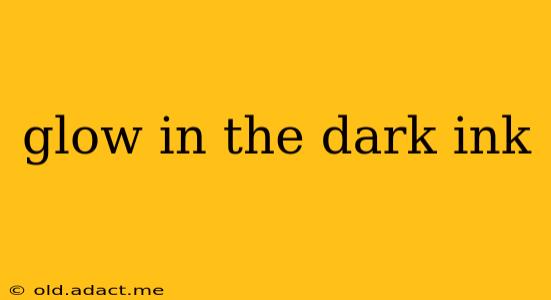Glow-in-the-dark ink, also known as phosphorescent ink, adds a touch of magic and excitement to any project. From crafting unique artwork to marking important items for easy nighttime visibility, its applications are diverse and intriguing. This comprehensive guide delves into the fascinating world of glow-in-the-dark ink, exploring its properties, uses, and considerations for optimal results.
What is Glow-in-the-Dark Ink Made Of?
Glow-in-the-dark ink doesn't produce its own light; instead, it absorbs and stores energy from an external light source, typically ultraviolet (UV) light or sunlight. This stored energy is then slowly released as visible light, creating the "glow" effect. The key ingredient is a phosphorescent pigment, usually a type of rare earth metal compound like strontium aluminate. The pigment's concentration directly affects the brightness and duration of the glow. The ink itself also contains a binding agent to hold the pigment in place and a solvent to allow for easy application.
How Long Does Glow-in-the-Dark Ink Glow?
The duration of the glow depends on several factors, including the quality of the ink, the intensity and duration of the charging light source, and the surrounding environment. High-quality inks can glow for several hours after a sufficient charge, while cheaper inks might only glow for a short time. Generally, expect a bright glow for the first hour, gradually fading over subsequent hours. Darkness is crucial; ambient light will reduce the visibility of the glow.
What are the Different Types of Glow-in-the-Dark Ink?
While the core principle remains the same, glow-in-the-dark inks vary in their properties. Some are designed for specific surfaces, such as paper, fabric, or plastic. Others offer different glow intensities and durations. There are also inks formulated for various writing instruments, including pens, markers, and paint. The choice depends heavily on your intended application and desired outcome.
What Surfaces Can You Use Glow-in-the-Dark Ink On?
Glow-in-the-dark ink can be applied to a wide range of surfaces, including paper, cardstock, canvas, wood, fabric, and some plastics. However, the absorption and adherence properties will vary depending on the surface's texture and porosity. It's always recommended to test the ink on a small, inconspicuous area first to ensure compatibility and satisfactory results.
Is Glow-in-the-Dark Ink Toxic?
Most commercially available glow-in-the-dark inks are non-toxic, especially those specifically marketed for children's crafts. However, it's crucial to always check the product label for specific safety information and handling instructions. Avoid ingestion and always ensure adequate ventilation when using the ink, particularly in enclosed spaces.
Where Can I Buy Glow-in-the-Dark Ink?
Glow-in-the-dark ink is readily available from various online retailers and craft stores. You can find it in different forms, including pens, markers, paints, and even powders for mixing your own ink. Comparing prices and reviews before purchasing is recommended to ensure you get a high-quality product that meets your needs.
How to Make Glow-in-the-Dark Ink Glow Brighter?
To maximize the glow, ensure the ink is fully charged by exposing it to a strong light source, such as direct sunlight or a UV lamp, for at least 30 minutes. The more intense and prolonged the charging period, the brighter and longer-lasting the glow will be. Keep the surface clean before application and avoid any obstructions that could reduce light exposure.
Conclusion
Glow-in-the-dark ink opens up a world of creative possibilities, adding a unique and exciting element to various projects. By understanding its properties and employing the right techniques, you can achieve stunning results, from glowing artwork to practical nighttime markings. Remember always to prioritize safety and follow the manufacturer's instructions for optimal results.
